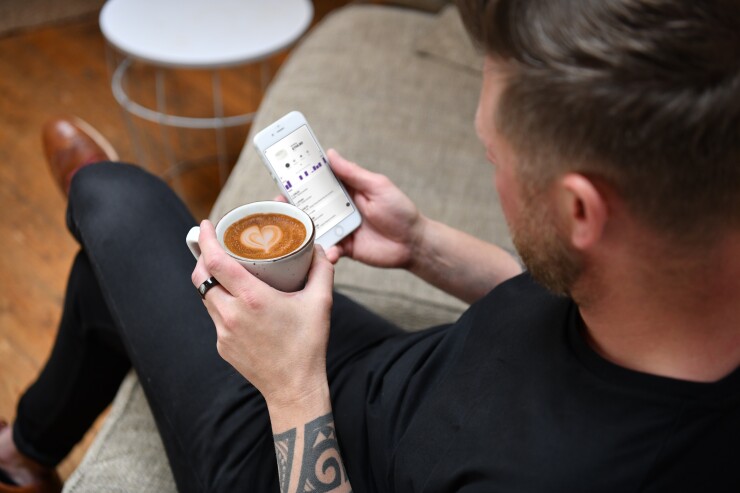On Monday, Quontic Bank began offering customers an unassuming black band embedded with contactless payment technology that they can use at point-of-sale terminals.
Such devices exist in other countries.
But Quontic, a $916 million-asset community development financial institution in New York City, says it is the first financial institution to offer one in this country.
Will consumers take to a debit card disguised as jewelry when they can already pay by hovering their cards, smartphones, fitness trackers or smartwatches above a contactless terminal?
“Right now the market for contactless payments is dominated by credit cards and smartphones,” said Michael Diamond, senior analyst at Futurum Research, a research firm that focuses on digital innovation. “The smart-ring segment is still niche.”
Still, he says contactless payments are here to stay.
In Visa’s first-quarter earnings call in 2022, CEO Alfred Kelly noted that tap-to-pay methods are nearing 20% penetration in the U.S., with New York City seeing even stronger growth at 45%. Mastercard
Diamond foresees situations where a payment ring could be more convenient than other payment methods, such as at the beach or pool, or while exercising, attending a concert or traveling. Another plus is the ring does not need to be charged.
“With the internet of things, people want products that are lighter, can do more and last longer,” Diamond said. “Wearable devices are a big market.”
The project has been in the works at Quontic Bank since CEO Steve Schnall discovered the makers of the ring, McLEAR, at the Money2020 conference in Europe in 2019 and ordered 10,000 almost on the spot because it felt intriguing and fresh. It’s what Aaron Wollner, chief marketing officer at
The bank would normally pore over data, study gaps in the market and identify an audience before launching a new product.
Its tap-to-pay payment ring is not one of those products. “There is no file cabinet full of research documents about
The market demand for this item has yet to be determined.
“Does the world need a payment ring? Not really,” Wollner said. “We are not trying to replace anyone’s wallet.”
Although the bank has already piloted the ring with employees and a portion of existing customers, the real test will be now that the ring is available more widely.
New customers will have to sign up for a checking account with Quontic. This month the Pay Ring is free, but it will eventually cost $29 apiece — which Wollner acknowledges is a loss for Quontic. The company settled on this price because it figured the customers who were willing to pay were more likely to use it.
“We didn’t do it for revenue, because it’s not a real revenue play,” said Wollner. “At some point, we want this to be a contributor to revenue, but there is no long-term plan to jack up the price to make a [certain] margin on the ring.”
Long lead time
Quontic
The bank also put thought into the design. The ring, which is constructed from zirconia ceramic, arrives in a slim white box to mimic the feel of unboxing an Apple device. The band itself is only available in black. The Mastercard logo is printed subtly inside the band.
The tap-to-pay action requires a slightly different technique than other forms of contactless payment, so Quontic posted a video on its website to demonstrate — fist closed as if one is about to knock on a door. (It’s like a light boop, said Wollner after meeting at a local coffee shop for an in-person tutorial.) To prove that the ring is water-resistant, Quontic converted a video an employee took of her boyfriend trailing his hand in the water while kayaking into a GIF, ring on his finger as he scoops up a handful of wet sand and lets it run through his fingers.
The bank expects the novelty will also be a selling point.
“We felt like we were providing a bit of excitement, almost some newness to this category,” said Wollner.
In his experience, about half the time someone uses their ring, a cashier or a person waiting in line to pay will be wowed.
Test drive
My own experience backs this up. Out of four attempts to pay with my test ring, two sparked reactions.
“I’m very intrigued,” said the cashier at Compass Coffee as I fumbled to purchase my croissant by repeatedly tapping my knuckle against the screen before the machine finally beeped to indicate success.
I also took the ring on grocery-shopping trips to Trader Joe’s. “What is that?” exclaimed a cashier as I pressed the device against his payment terminal, now a pro at paying in seconds.
Whenever I explained the concept to friends, they were in awe. But reactions were mixed as to whether they would go as far as buying a ring and opening an account when their phones were always with them.
Wollner says that acquiring customers is a secondary goal, although he expects some people will sign up for a Quontic checking account just to get the ring.
“We did this because it fits our identity as an innovative digital bank,” he said. “We want to be the bank that got you into wearables.”






